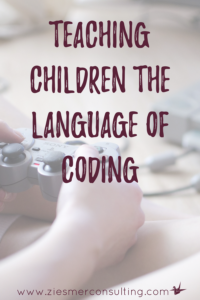I am just amazed at my five year old grandsons level of proficiency with coding. Of course, he is like many other young children and loves video games. He can create a level on the Mario Game builder video game that no one can beat except him.
As I have watched him and thought about this I began to look at the question of “how can teachers, expand on this in the classroom and promote digital learning while also not encouraging a life of losing oneself to a screen?” Let me share what I have learned.
What is Coding?
Let’s start with the basics – what exactly is coding? Well, coding is basically digital language. It is essentially computer programming. You need to speak the language of a computer chip so it will understand what you want it to do. You do this by creating step by step instructions. Pretty much anything electronic these days needs code to run. It doesn’t matter if it is a phone, tablet, game system, or appliance. If it has a computer chip in it; it will need code in order to work properly.
Code is part of the language of our time. So much of today’s world and the global community revolves around some sort of technology. We can no longer deny that code now has a role in our education system. As with any domain, the language of coding needs to begin in the early years.
Young children are easily excited and engaged in learning. They are naturally curious and enjoy exploration and adventure. Many of the activities we already do with children are the precursors to learning to code. Using stories and games that include coding is a fun, hands on way for children to begin to experiment with the language. Coding uses the same early math and literacy skills that are already embedded into many of the current curriculums.
Like many learning strategies it is important to lay the groundwork for future success in coding with young children. Once they have a solid foundation it will be much easier for them to build and apply these concepts later in life.
Children are already engaging in and initiating activities that will give them early coding skills. These are the same skills they need for many other domains. Problem solving, communication and critical thinking all integrate the skills that are critical for success in a digital world. If you look at the things children play with such as blocks and toy cars for example, helping them use directional language while they are giving each other instructions is one way to promote coding concepts.
Activities to introduce coding
Playing or creating board games is another way for them to begin to understand directional movement, and following commands. Creating and following a treasure map would be a fun activity in which they can explore direction, movement and location in a way that would be an exciting adventure for them. The same concepts of spatial reasoning and number sense that these types of activities support are also preparatory activities for coding that children can practice without using a computer.
The beginning of coding is essentially pre math skills. Introducing counting skills and expanding language by using representations such as first, second, third or up, down, left, right will help to strengthen and support their early math skills as well as their coding skills. Allowing children a variety of opportunities to explore the different concepts and practice using the skill of directional language while playing will give children a good start into the world of coding and digital vocabulary.
For fun and engaging ideas, follow me on facebook!








Leave a Reply